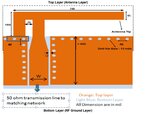SuBill
Junior Member level 3
Dear all,
I'm new of RF design, especially HFSS simulation. I'm so confused of how to really design and simulate an antenna correctly using HFSS. Please help me in these following regards:
1. Lumped port position:
- I know it should be between the ground plane and the signal path. But for an IFA as attached (designed by TI, for 900Mhz), I'm not sure where to put the port. The pink one is the lumped port. Is it correct?
- For the more complicated IFA antenna (2nd file attached), where should I put the port? Is it between the end of the antenna trace (right at the text "50ohm transmission line" and the bottom layer which acts the RF ground plane? If yes, in details, I'll draw a port at the end of the trace going down to the bottom layer?
2. Virtual radiation boundary and air box:
- The correct virtual radiation boundary dimension should be more than lamda/2, right? Can I just simply make the distance from each edge of the substrate to any face of the boundary to be slightly more than lamda/4?
- The air box is made 30% bigger than the virtual radiation boundary.
4. Design parameters:
- Could you please give me any equation or method to design an IFA antenna? I've read some materials and they just gave out the parameters, not how to do it. So when I got problem with the result, I do not know how to adjust them.
- For the IFA designed by TI, if I put a bottom layer as another GND plane, the simulated result was totally wrong!
Thank you very much and look forward to your support!


I'm new of RF design, especially HFSS simulation. I'm so confused of how to really design and simulate an antenna correctly using HFSS. Please help me in these following regards:
1. Lumped port position:
- I know it should be between the ground plane and the signal path. But for an IFA as attached (designed by TI, for 900Mhz), I'm not sure where to put the port. The pink one is the lumped port. Is it correct?
- For the more complicated IFA antenna (2nd file attached), where should I put the port? Is it between the end of the antenna trace (right at the text "50ohm transmission line" and the bottom layer which acts the RF ground plane? If yes, in details, I'll draw a port at the end of the trace going down to the bottom layer?
2. Virtual radiation boundary and air box:
- The correct virtual radiation boundary dimension should be more than lamda/2, right? Can I just simply make the distance from each edge of the substrate to any face of the boundary to be slightly more than lamda/4?
- The air box is made 30% bigger than the virtual radiation boundary.
4. Design parameters:
- Could you please give me any equation or method to design an IFA antenna? I've read some materials and they just gave out the parameters, not how to do it. So when I got problem with the result, I do not know how to adjust them.
- For the IFA designed by TI, if I put a bottom layer as another GND plane, the simulated result was totally wrong!
Thank you very much and look forward to your support!

